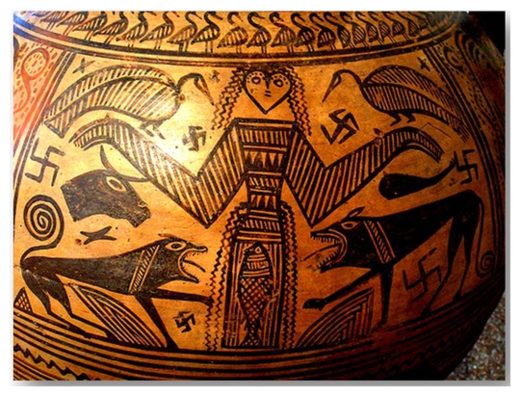
"Within about two minutes, all the Nazi symbolism was gone," one subway rider who was there said. "Everyone kind of just did their jobs of being decent human beings."
That sentiment was reflected in a tweet from New York Gov. Andrew Cuomo:
"This is what New Yorkers do — we turn hate into love. And we won't back down — not now, not ever."
That two-minute incident on a northbound No. 1 train underneath Manhattan is a blip in the swastika's 6,000-year history. The plus-sign symbol with four hooked arms all pointing either clockwise or counterclockwise appeared in Asian, African, North and South American cultures millennia before Adolf Hitler and the Nazis made the clockwise version of it the emblem of their murderous aggression for 25 years.
Yet the Nazis' brief but horrendous association with the swastika managed to divorce the symbol from its original ties to religion and spirituality, at least for Western cultures, though it is still used and revered by Buddhists, Hindus, Jains and others.
How did the swastika travel from prehistorical India to a New York City subway last week? Can it ever be restored to its original place as a sign of fertility, good fortune and hope?
And in a broader sense, how likely is it in this age of globalization and rapid-fire social media that an ancient hooked cross, a sad-faced frog or the name of an Egyptian goddess can be reclaimed from their hate-related associations?
"The swastika is the most complex symbol of any civilization," said Steven Heller, a graphic designer who teaches at New York's School of Visual Arts and is the author of "The Swastika: Symbol Beyond Redemption?" "For some, it has a great history that was perverted for only 25 or 30 years. For others, that perversion nullifies it."
The word "swastika" comes from Sanskrit and is variously translated as "well-being" or "self-existing," a kind of spiritual affirmation and good-luck symbol. It was sacred to early Hindus and Buddhists, who used it as early as 3000 B.C. in the Indus Valley. One theory holds that ancient peoples traveled a trade route to other cultures, taking the swastika with them in the designs of baskets, blankets and pots.
Another theory is that the symbol is so elemental it appeared in several cultures and spread to others that adapted it for their own uses. Swastikas are found in Celtic stone carvings, Nordic ornamentation, Greek and Roman mosaics, Native American blankets, Mayan ruins and Jain temples.
In the late 19th century, German archaeologist Heinrich Schliemann found the swastika in the ruins of ancient Troy, on the plains of contemporary Turkey. Schliemann believed the swastika emanated from an ancient Aryan tribe that found its way to Troy and, eventually, Europe and Germany.
Schliemann described the swastika as a "significant religious symbol of our remote ancestors."
Heller says Schliemann's discovery of Troy was "like the moon landing" of its time. His discoveries captured the Western imagination and soon swastikas were popping up everywhere — in the patterns of wedding dresses, on greeting cards and decorative objects and in advertising. In the U.S., Coca-Cola, the Boy Scouts and military regiments all used the swastika.
Schliemann's theory found dark traction in Germany, where nationalist sentiments were bubbling to the surface. At first, it was used by scattered anti-Semitic groups, and by 1920, the Nazi Party adopted it, using only the clockwise rendition of the arms of the central cross. In Mein Kampf, Hitler wrote of how he deliberately chose the swastika to represent Nazi goals:
"In red we see the social idea of the movement, in white the Nationalist idea, and in the swastika the vision of the struggle for the victory of the Aryan man."
After World War II, Germany banned the use of the swastika and the "runes" — the lightning-boltlike, double capital S used by the Schutzstaffel, or SS. These symbols are still so loaded they remain outlawed in Germany.
The swastika isn't alone in its ignominy. Since the rise of the Islamic State group, often referred to as ISIS, a handful of businesses and products have changed their names, and Pepe the Frog, intended as a lighthearted figure, is now an emblem of white supremacists.
But some once-hated symbols have been successfully rehabilitated. The lesbian, gay, bisexual and transgender community adopted the pink triangle given to "sexual deviants" in the Nazi concentration camps and made it a rallying point for gay pride; and the Christian cross was once an image of terror, used by the Romans to threaten a torturous execution.
Several contemporary groups have tried to reclaim the swastika as a positive spiritual symbol. Canadian artist ManWoman founded Friends of the Swastika and wrote Gentle Swastika: Reclaiming the Innocence in 2001. In a vision, ManWoman said, a spirit commanded that he reclaim the swastika "so that it would strike love into all hearts that beheld it."
In 2013, American designer Sinjun Wesson produced clothing with a "swasi" as part of his Spiritual Punx line.
"If the hate is taken away from the symbol by energizing its positive side, then we take away power from the people who want to use it in a hateful way," Wesson told The Atlantic in 2014. "If we don't do anything and just leave it as negative, then we still let hate win."
Heller posted a video of his swastika lecture in 2014, before the recent rise in anti-Semitic incidents. Now, the question mark at the end of the title of his book seems less definite.
"What we were seeing over the weekend is the symbol is proving itself to be irredeemable this close to the Holocaust," he said. "Even though the Holocaust survivors are almost gone, it is still in our literature, in our plays and the like."
The swastika is currently featured prominently in the popular Amazon series The Man in the High Castle, set in a world where the Nazis triumphed in World War II and have a seat of power in New York City. And many have criticized the new president and his top aides for not distancing themselves from white supremacists, white nationalists and other groups that brandish the Nazi swastika as a symbol of hatred.
"As long as there are histories of this kind," Heller said, "as long as there are films of this kind, as long as there are people like Steve Bannon and, sadly, Donald Trump, this stuff exists.






Reader Comments
[Link]
Symbol of good luck? Maybe! Provided the comet passed without striking the Earth
[Link]
(Atlantean Gardens 'take').
Always learning I guess..
There are lot of online pundits who think the swastika relates in someway to ancient Atlantean techno. Of course, it's just a mountain of speculation and wildly connected dots, but I find it all very interesting nonetheless.